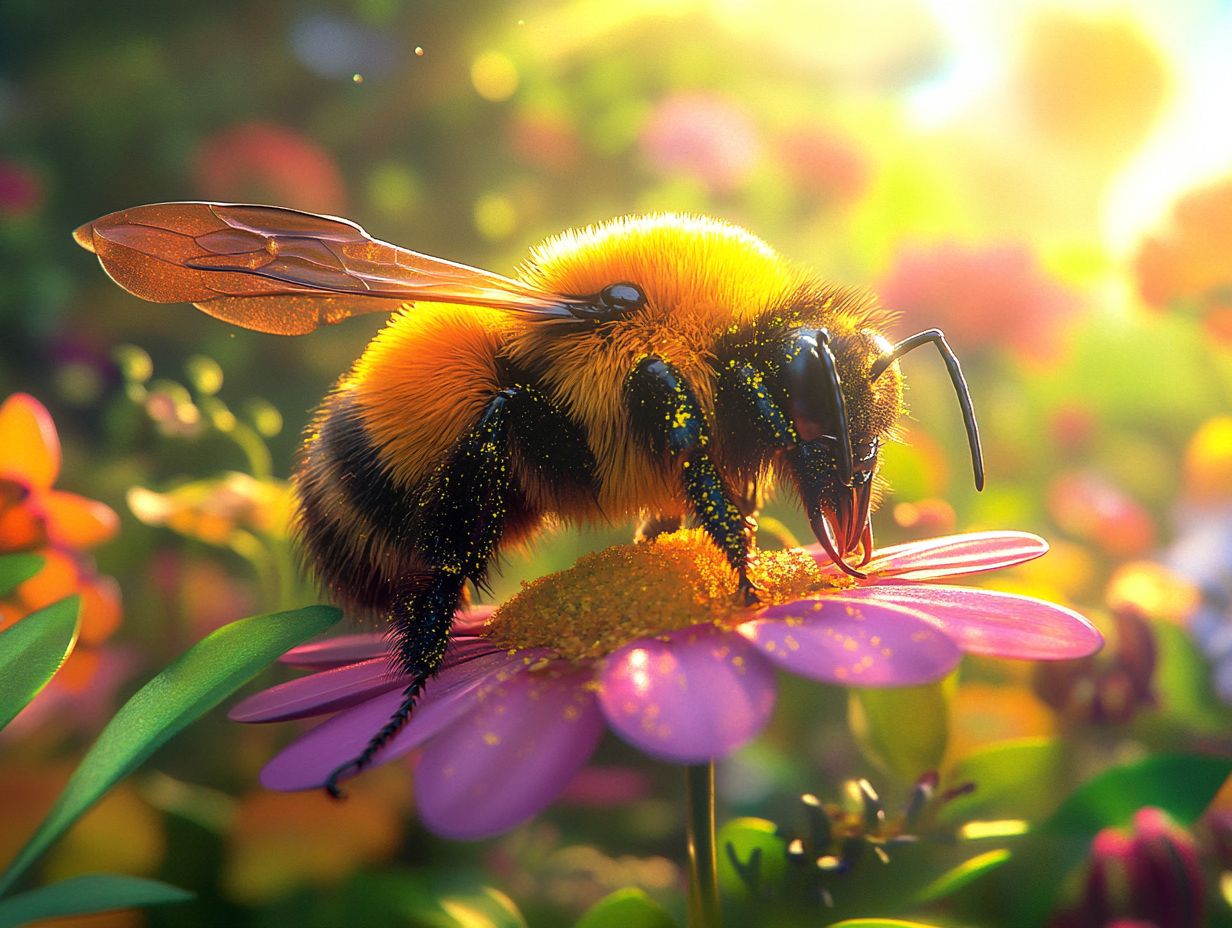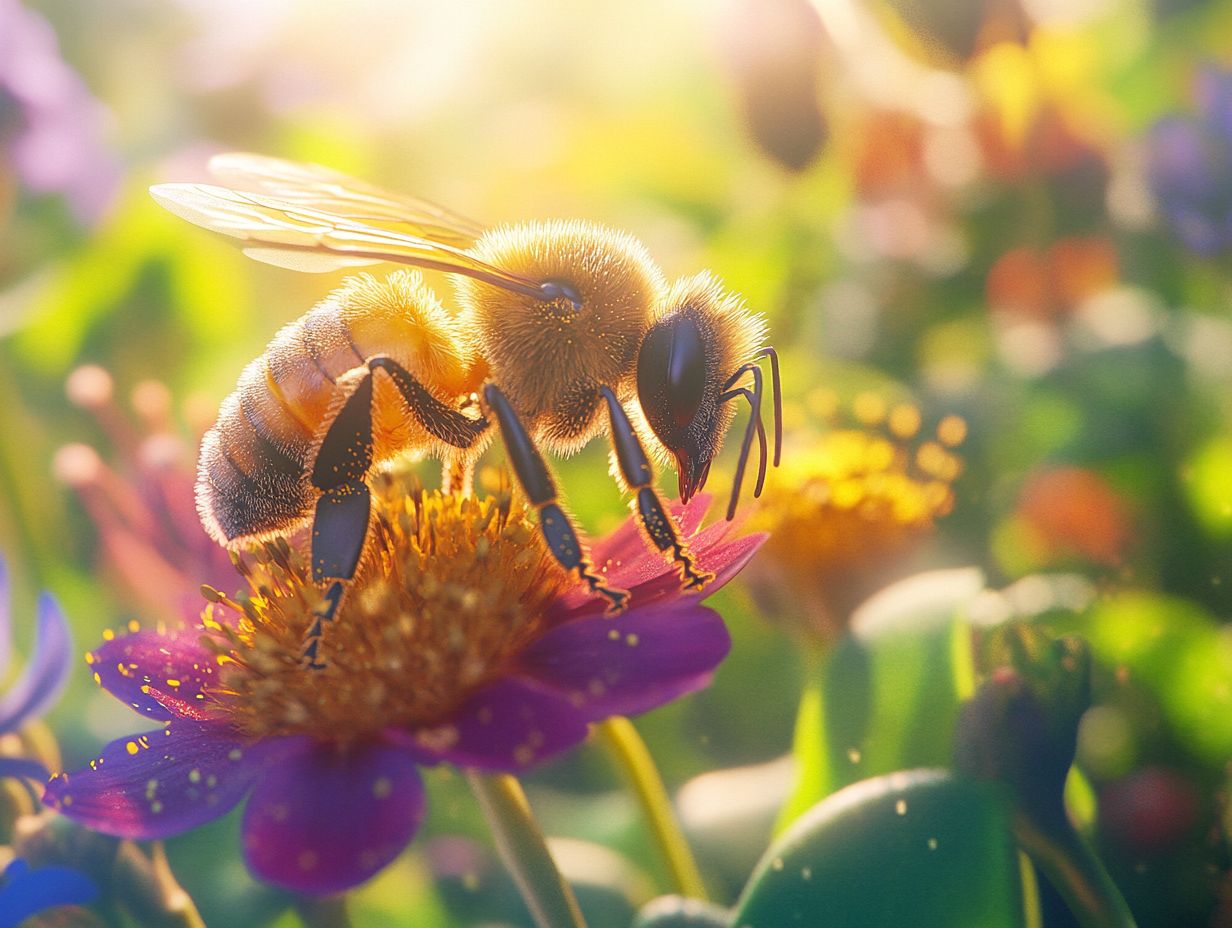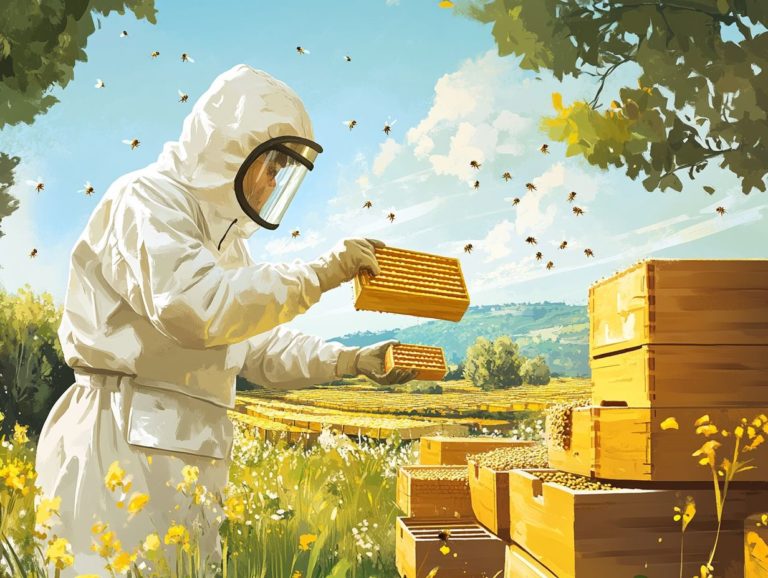How Bees Sense Their Environment
Bees are truly remarkable creatures, gifted with an extraordinary array of senses that allow them to navigate their bustling world with ease. From the vibrant hues of blooming flowers to the subtle yet alluring scents of nectar, these tiny pollinators leverage their keen sensory abilities for navigation, communication, and foraging flights.
In this exploration, you will uncover the fascinating ways bees perceive their surroundings, including their unique vision, acute sense of smell, sensitive touch, and even their surprising hearing capabilities. Delve into how these senses not only guide their daily activities but also play a crucial role in keeping them safe from danger, navigating their environment, and recognizing different species.
Contents
Key Takeaways:

- Bees have five main senses: vision, smell, touch, hearing, and taste.
- These senses help bees navigate and communicate with each other, find food, protect themselves from predators, and maintain environmental awareness.
- Bees have specialized adaptations, such as compound eyes and antennae, to enhance their senses and survive in their environment.
How Do Bees Sense Their Environment?
Bees, especially honeybees (Apis mellifera), have extraordinary sensory capabilities. These abilities help them interact with their environment in remarkable ways.
Their sophisticated sensory perception includes a range of modalities. For instance, olfactory receptors are specialized cells that detect smells and help bees sense pheromones, which are chemical signals used for communication. There are also visual signals that aid bees in navigating floral patterns and tactile senses that facilitate their understanding of hive dynamics.
These adaptations allow you to witness how efficiently bees forage, communicate within their colonies, and respond to various environmental stimuli. The interplay of these senses allows them to recognize different species, highlighting their collective behavior and ecological significance in both pollination and honey production.
What Are the Different Types of Bee Senses?
Bees possess a remarkable array of senses that are vital for their survival and interaction with the world around them. Their primary senses include olfactory receptors, which enable them to detect pheromones and other chemical signals. They also have visual perception that allows them to discern ultraviolet colors and identify flowers and nectar guides.
Taste receptors located on their antennae help them assess food sources. Their ability to interpret tactile sensations proves crucial for activities such as comb building and hive maintenance.
These sensory adaptations not only enhance communication within the hive but also play pivotal roles in navigation and foraging. For instance, the olfactory sense allows bees to recognize the scent of queen pheromones, which is essential for maintaining the colony’s social structure and collective behavior. Alarm pheromones also help bees respond to threats.
Their exceptional vision lets them see floral patterns that humans cannot. This helps them find nectar-rich flowers crucial for the pollination process that supports ecosystems and agriculture alike. Tactile cues also help bees assess their surroundings when interacting with hive members, ultimately enhancing cooperation and efficiency within their intricate communities. They also use spatial navigation skills to map their environment.
Bees actively use their senses and learn from their surroundings to thrive in their environment.
Bees employ their remarkable sensory perception to navigate their surroundings and communicate seamlessly with one another. Their olfactory receptors play a vital role in detecting pheromones, which act as chemical signals for a range of communications within the hive, including alarm pheromones.
Visual cues, such as ultraviolet patterns on flowers, guide bees during foraging flights. The renowned waggle dance performed by worker bees is a sophisticated way of sharing information about food sources’ locations, highlighting the extraordinary collective behavior of bee colonies and their adeptness in interacting with their environment. Bees also rely on their ability to perceive the magnetic field to orient themselves during these flights.
How Do Bees Use Their Vision?
The visual perception of bees is truly captivating. They possess the ability to see ultraviolet colors that remain hidden from human eyes, enabling them to spot nectar guides on flowers. This skill enhances their flower constancy and leads them to prefer visiting the same species during their foraging flights. This boosts their efficiency in gathering nectar and pollen.
You might find it intriguing that bees rely on their eyesight for estimating distances, a crucial ability for navigating between their hive and food sources. Their vision also assists in flight path orientation and image flow.
The way bees perceive their environment significantly influences their foraging behavior. Take lavender and daisies, for example these flowers feature intricate patterns that attract bees, thanks to their vibrant, UV-reflective markings. These markings function like road signs, guiding the bees to the nectar hidden deep within the blossoms.
Such visual cues are essential not only for locating food but also for creating a mental map of their surroundings. This combination of colors and patterns allows bees to optimize their foraging routes, quickly pinpointing the most rewarding nectar sources across diverse landscapes. They also use temporal resolution to judge the timing and quality of food sources.
How Do Bees Use Their Sense of Smell?
Bees depend greatly on their remarkable sense of smell, aided by specialized smell sensors, to navigate their surroundings and interact with one another. They can detect a variety of chemical signals, including the queen’s pheromone, which plays a key role in maintaining the hive’s social structure. Alarm pheromones serve as alerts to fellow hive members about potential dangers.
This heightened olfactory sensitivity gives bees the ability to locate food sources and convey crucial information about the hive’s well-being, ensuring effective chemical communication. Their knack for distinguishing specific scents is pivotal when foraging.
For example, when searching for nectar, bees can pick up floral scents from considerable distances, effectively guiding them to abundant food sources. Gatherers communicate back to the hive through unique scent markers, optimizing the allocation of resources.
This intrinsic connection to olfactory signals not only influences individual behaviors but also nurtures cooperation within the hive, ensuring that every member plays a vital role in the colony’s prosperity.
How Do Bees Use Their Sense of Touch?

Bees possess an impressively sensitive sense of touch through their antennae and body hairs, enabling them to perceive touch sensations in their environment with remarkable acuity. This tactile sensitivity is paramount when navigating their surroundings, assessing the surfaces of flowers, and executing intricate tasks like building their combs within the hive.
They depend heavily on touch to evaluate the quality of potential nectar sources, as the texture of a flower’s surface can indicate its readiness for pollination. When foraging, bees employ their tactile abilities to selectively gather pollen and nectar, ensuring they choose the most suitable flowers, which supports plant reproduction.
Within the confines of their intricate hive architecture, tactile sensations are essential; bees gauge the wax consistency and structural stability necessary for constructing and repairing their combs. This ensures a safe and organized living space for their colony.
How Do Bees Use Their Sense of Hearing?
While you might think bees are at a disadvantage without traditional ears, they possess a remarkable ability to detect vibrations through specialized structures in their bodies, effectively allowing them to ‘hear’ the sounds of their environment. This talent is essential for communication among bees, particularly when it comes to interpreting the sounds of the waggle dance or the vibrations produced during hive activities. Grasping these vibrations is crucial for maintaining hive dynamics and social cohesion.
Bees employ their antennae and various sensory organs to pick up on these subtle vibrations, which relay vital information about food sources and the overall conditions within the hive. For example, the intensity and frequency of the vibrations linked to the waggle dance a unique movement bees perform to communicate the location of food sources provide other bees with precise details about the distance and direction of nectar-rich flowers. During times of distress, such as when a predator threatens the hive, specific vibrational signals alert the community to mobilize for defense. When danger approaches, bees spring into action! They send vibrational signals that rally the hive to defend their home, showcasing their remarkable collective behavior.
This perceptive capability not only enhances their collective intelligence but also promotes collaboration during foraging and nurturing the queen, highlighting the intricate social structure that characterizes their vibrant communities. Bees also use polarization patterns of light to navigate and find food sources effectively.
How Do Bees Use Their Senses to Find Food?
Bees skillfully harness a blend of their senses to efficiently locate food sources, with a primary focus on the nectar of flowers. Their keen olfactory signals allow them to detect floral scents from impressive distances, directing them toward the nectar. They rely on their memory and learning abilities to remember and refine their foraging routes.
Visual cues, such as flower patterns and colors, significantly influence their foraging flights, enabling them to select the most rewarding plants. This seamless integration of sensory modalities enhances their foraging success, ensuring a consistent food supply for the hive and contributing to honey production.
How Do Bees Use Their Sense of Smell to Find Flowers?
The sense of smell is very important for bees when they search for flowers. Their smell sensors help them find flowers that have nectar, guiding them efficiently during their foraging flights. Without their keen sense of smell, bees would struggle to survive, making their olfactory receptors crucial for their day-to-day life.
By recognizing and remembering these floral odors, bees enhance their foraging efficiency. This ensures the hive has access to the necessary food resources. Honey production is directly linked to the bees’ olfactory memory of these scents.
Bees rely on a variety of scents produced by different plants, from sweet floral fragrances to unique volatile compounds that signal the presence of nectar. Each visit to a flower reinforces the connection between scent and reward in their olfactory memory.
Interestingly, this memory is not just fleeting; bees can recall these scents over considerable periods, enabling them to return to their favorite blooms time and again. This behavioral trait is known as flower constancy, which enhances the bees’ foraging efficiency.
This intricate olfactory system not only aids in their foraging endeavors but also plays a vital role in pollination, highlighting the essential contributions they make as a pollinator to the ecosystem and agricultural productivity.
How Do Bees Use Their Sense of Vision to Find Flowers?
Bees have a remarkable way of using their vision to seek out and identify flowers, taking full advantage of their ability to see ultraviolet colors that are often beyond human perception. This extraordinary visual capability enables them to spot nectar guides on flowers, acting as beacons that direct them straight to where the nectar is. By recognizing specific floral patterns and ultraviolet color, bees can efficiently hone in on their foraging efforts, ensuring they make the most of their nectar intake while simultaneously pollinating plants.
This exceptional visual perception is vital for their foraging behavior, especially when it comes to flowers like daisies and clover, which flaunt striking UV patterns. For instance, the common bluebell sports ultraviolet markings specifically designed to attract bees, guiding them directly to the nectar. These visual cues not only enhance the flowers’ appeal but also significantly improve the bees’ efficiency, allowing them to quickly identify the most rewarding blooms in their surroundings.
Additionally, bees use their visual signals to recognize different species, ensuring they target the right flowers.
This intricate dance between floral traits and bee vision beautifully illustrates the symbiotic relationship that thrives within ecosystems. Plants rely on bees for reproduction, offering nutritional rewards like nectar and pollen in return, creating a harmonious cycle of life that benefits all involved.
How Do Bees Use Their Sense of Touch to Find Flowers?
The sense of touch is essential to how you observe bees finding and interacting with flowers. Their tactile sensations allow them to assess the texture of flower petals, enabling them to determine which ones are ideal for landing and feeding. This tactile feedback is crucial for their ability to access nectar and pollen efficiently, all while ensuring they don’t damage the flowers during their foraging flights.
Bees often use their antennae for these tactile assessments, which also play a crucial role in other sensory perceptions like smell and taste.
Imagine bees expertly navigating flowers, using their sensitive hairs to make split-second decisions that can mean the difference between a good or bad meal! As you explore this fascinating world, you’ll notice that bees rely on their sensitive hairs and specialized sensory organs to navigate the various surfaces of flowers, adapting their foraging strategies based on the textures they encounter. For instance, velvety petals often serve as a welcoming, cushioned landing pad, drawing bees in with their ease of access and comfort. On the flip side, rougher, spiky flower surfaces can deter certain bee species, subtly influencing their foraging patterns.
This sense of touch is closely linked with their taste receptors, allowing bees to make quick decisions about the quality of the nectar they are collecting. This amazing talent for noticing tiny differences not only boosts their feeding efficiency but also plays a pivotal role in pollination. By selecting flowers that align with their tactile preferences, bees ensure effective pollen transfer, ultimately supporting the delicate balance of the ecosystem.
How Do Bees Use Their Senses to Protect Themselves?

You ll find that bees utilize their remarkable senses not just for foraging but also for self-defense against predators. Their keen smell and visual capabilities allow them to detect threats with impressive precision.
When they recognize alarm pheromones released by their fellow hive members, they can swiftly coordinate a collective response to potential dangers. Their sharp visual perception aids in navigating and avoiding obstacles, which plays a crucial role in escaping threats and safeguarding the hive. Knowing how queen pheromones and other signals work helps keep the hive running smoothly.
How Do Bees Use Their Sense of Smell and Chemical Communication to Detect Predators?
Your sense of smell plays a critical role in how bees detect predators. They can pick up on alarm pheromones emitted by fellow bees when danger approaches. These chemical signals empower them to identify impending threats and trigger a rapid defensive response, ensuring the hive’s safety.
By constantly monitoring their surroundings through smell signals, bees can stay alert against potential predators.
With finely tuned antennae, they can detect even the faintest traces of these pheromones, allowing them to pinpoint trouble before it escalates. For example, when a wasp or hornet threatens their hive, the bees release alarm pheromones that signal urgent danger. This swift response can mean the difference between life and death for the hive! It initiates a range of aggressive behaviors, including coordinated stinging and mass formations to protect their queen and brood.
Their ability to distinguish different types of chemicals enables them to identify a variety of predators, greatly enhancing their survival chances. This heightened sense of smell is especially crucial in environments teeming with threats, from birds to larger mammals.
How Do Bees Use Their Sense of Vision to Avoid Obstacles?
Bees possess a remarkable ability to navigate their surroundings with precision, allowing them to deftly avoid obstacles during flight. This skill is essential, as it enables them to estimate distances and recognize visual cues crucial for preventing collisions and optimizing foraging. Their short-sightedness and high temporal resolution allow them to detect rapid movements and navigate effectively.
By processing visual information in real-time, bees can easily adjust their flight paths, ensuring safety even in complex environments.
This amazing ability allows bees to maneuver skillfully through gardens, fields, and forests, effortlessly dodging branches, flowers, and various potential obstacles. As they approach a flower, their vision helps them gauge distance and discern shape and color key factors in identifying optimal sources of nectar and pollen. Bees’ capability of distance estimation and spatial navigation are fundamental to their foraging behavior.
Research has shown that bees excel at spotting movement, significantly enhancing their ability to respond quickly to nearby threats. Ultimately, these visual skills are vital for bees to thrive in their dynamic habitats, enabling them to fulfill their essential roles in pollination and the maintenance of biodiversity. This visual acuity also helps them in comb building and other hive-related activities.
How Do Bees Use Their Sense of Touch to Communicate Danger?
Bees have a fascinating ability to communicate danger through tactile sensations. Vibrations serve as a crucial means of conveying alarm signals to their fellow hive members. These vibrations resonate through the hive structure, effectively alerting other bees to potential threats. This form of tactile communication enhances hive dynamics and enables a collective and efficient response to danger.
When bees sense a threat, whether from a lurking predator or an environmental disturbance, they spring into action. They create rapid vibrations by fanning their wings or moving quickly inside the hive. This pattern of pulsations spreads almost instantaneously throughout the colony, ensuring their collective behavior during such events promotes the hive’s survival.
Neighboring bees respond to these vibrations, promptly adjusting their behavior either reinforcing their defenses or preparing to flee. This intricate dance of tactile signals illustrates the hive’s remarkable capacity to act cohesively in moments of crisis, emphasizing the essential role of touch and vibration in safeguarding the colony s safety and survival.
How Do Bees Use Their Sense of Hearing to Communicate with Other Bees?
Bees may not have conventional hearing. However, they can detect vibrations and sounds in their environment, which is crucial for their communication strategies. These vibrations convey critical information regarding the hive’s status or alert fellow bees to potential threats. Understanding these auditory cues enhances our appreciation of how bees maintain hive dynamics and social cohesion. Karl von Frisch’s pioneering research on the waggle dance significantly advanced our understanding of these communication methods.
Consider this: when a forager bee returns to the hive, it engages in a dance that tells others where to find food. This fascinating behavior shares important information and creates shaking that the entire colony can feel. Guard bees generate specific vibrations to warn others about intruders or nearby predators, prompting a rapid response from the entire hive. These signals play a crucial role in their communication strategies, alongside visual and olfactory signals.
In these scenarios, it’s clear that sound and vibrations are vital components of bees’ intricate social structure. They enable quick and effective communication, ultimately supporting the colony s survival and thriving existence. The colony’s remarkable learning abilities and environmental awareness further enhance their survival.
Frequently Asked Questions
How do bees sense their environment?

Bees use a combination of sensory capabilities, including smell receptors, visual perception, taste receptors, and tactile sensations to navigate and interact with their environment. These senses allow them to forage for food, communicate with other bees, and protect their hive.
Honeybees (Apis mellifera) have a variety of sensory mechanisms that enable them to sense and navigate their environment. Their sensory perception and environmental awareness are crucial for their survival and ecological importance.
What role does vision play in a bee’s sense of their environment?
Bees have compound eyes that allow them to see ultraviolet light and color patterns, which act as nectar guides to direct them to nectar-rich flowers. This visual perception also aids in spatial navigation, allowing them to perform foraging flights and navigate to and from their hive.
How do bees use their sense of smell?
Bees have antennae that are highly sensitive to odors and equipped with smell receptors. This capability allows them to locate food sources, communicate through chemical signals such as pheromones, and detect potential threats.
Can bees sense changes in the weather and their environment?
Yes, bees have a special organ called Johnston’s organ that allows them to sense changes in air pressure and temperature. This helps them navigate their environment and prepare for weather changes.
Do bees have a sense of taste?
Yes, bees have taste receptors on their feet and mouthparts, which facilitate taste perception. This allows them to taste different types of nectar and pollen, aiding their decision on which flowers to visit for food and contributing to their flower constancy behavior.
How do bees communicate with each other?
Bees use a combination of dance (such as the waggle dance), touch, and chemical communication through pheromones to communicate about food sources, potential threats, hive dynamics, and the location of their hive. Visual signals also play a role in their communication and orientation during foraging flights.
Have you ever wondered how bees know exactly where to find the best flowers? Their incredible abilities are truly a marvel of nature!






